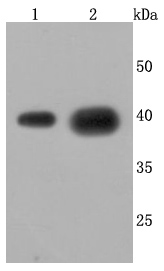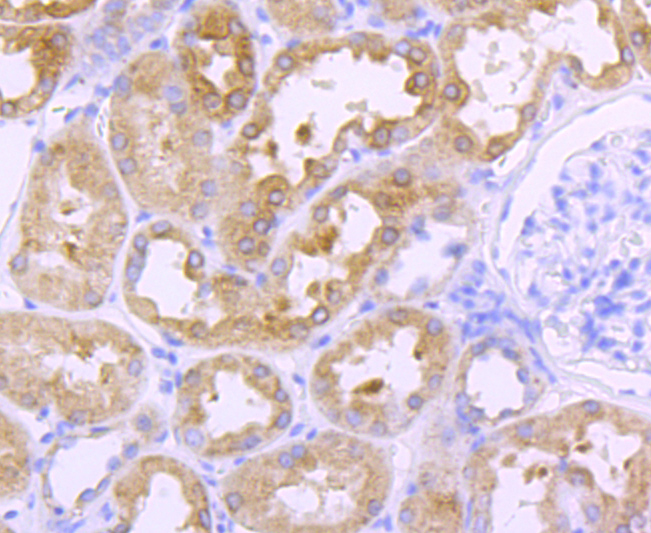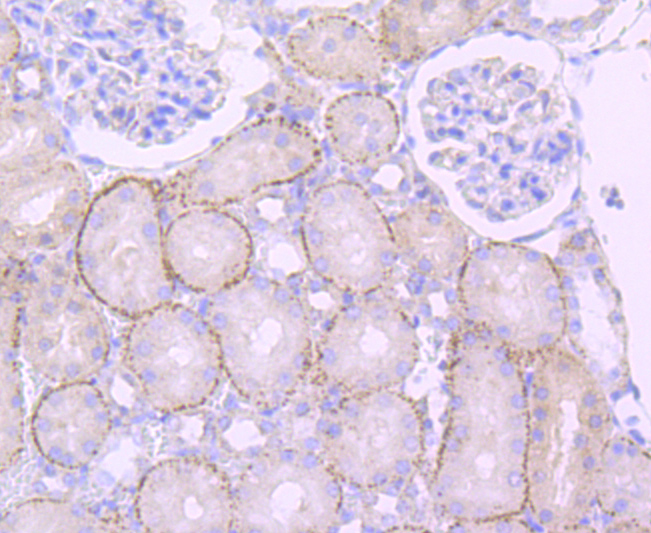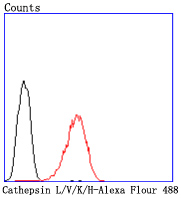Product Detail
Product NameCathepsin LVKH Rabbit mAb
Clone No.JM10-78
Host SpeciesRecombinant Rabbit
Clonality Monoclonal
PurificationProA affinity purified
ApplicationsWB, ICC/IF, IHC, FC
Species ReactivityHu, Ms, Rt
Immunogen Descrecombinant protein
ConjugateUnconjugated
Accession NoSwiss-Prot#:P07711
Uniprot
P07711
Gene ID
1514;
Calculated MW38 kDa
Formulation1*TBS (pH7.4), 1%BSA, 40%Glycerol. Preservative: 0.05% Sodium Azide.
StorageStore at -20˚C
Application Details
WB: 1:1,000-5,000
IHC: 1:50-1:200
ICC: 1:50-1:100
FC: 1:50-1:100
Western blot analysis of Cathepsin L/V/K/H on different cells lysates using anti-Cathepsin L/V/K/H antibody at 1/1,000 dilution. Positive control: Lane 1: HepG2 Lane 2: A549
Immunohistochemical analysis of paraffin-embedded human kidney tissue using anti-Cathepsin L/V/K/H antibody. Counter stained with hematoxylin.
Immunohistochemical analysis of paraffin-embedded mouse kidney tissue using anti-Cathepsin L/V/K/H antibody. Counter stained with hematoxylin.
Immunohistochemical analysis of paraffin-embedded rat kidney tissue using anti-Cathepsin L/V/K/H antibody. Counter stained with hematoxylin.
ICC staining Cathepsin L/V/K/H in HepG2 cells (red). The nuclear counter stain is DAPI (blue). Cells were fixed in paraformaldehyde, permeabilised with 0.25% Triton X100/PBS.
Flow cytometric analysis of HepG2 cells with Cathepsin L/V/K/H antibody at 1/50 dilution (red) compared with an unlabelled control (cells without incubation with primary antibody; black). Alexa Fluor 488-conjugated goat anti rabbit IgG was used as the secondary antibody.
The cathepsin family of proteolytic enzymes contains several diverse classes of proteases. The cysteine protease class comprises cathepsins B, L, H, K, S, and O. The aspartyl protease class is composed of cathepsins D and E. Cathepsin G is in the serine protease class. Most cathepsins are lysosomal and each is involved in cellular metabolism, participating in various events such as peptide biosynthesis and protein degradation. Cathepsin L (also designated major excreted protein, MEP or CATL) is a member of the peptidase C1 family and has been identified as a protein that is most closely related to cathepsin H. It is a lysosomal cysteine proteinase that mediates intracellular protein catabolism for collagen, elastin and ?-1 protease inhibitor. Cathepsin L is a dimer composed of disulfide-linked heavy and light chains, both produced from a single protein precursor. At least two transcript variants encoding the same protein have been found for this gene. Transformed mouse fibroblasts stimulated by growth factors or tumor promoters secrete a form of cathepsin L.
If you have published an article using product 49457, please notify us so that we can cite your literature.








 Yes
Yes



